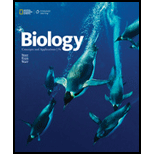
Introduction:
All the substances present in the environment are composed of elements. Biologist gave a sequence of an organization that is followed by every substance. This is known as the “level of organization.”
Answer to Problem 1SQ
Correct answer:
The fundamental building blocks of all matter are atoms. Hence, the correct answer is option a.
Explanation of Solution
Reason for correct answer:
Option a. is given as “Atoms”
The basic level of the organization includes “atoms, molecules, cells, tissues, organs, organ system, organisms, population, community, ecosystem, and biosphere.” The basic, fundamental building blocks that form all matter is an atom. The interaction of atoms results in the formation of molecules. Molecules interact to form cells. The cell is the basic “fundamental unit” of every living organism. The cellular interaction forms tissues and tissues link together to form organs. This formation cycle continues to grow and ultimately forms biosphere. The biosphere is the largest level of organization, and it contains all the substances (both living and non-living) that are present in the environment. Hence, option a. is correct.
Reason for incorrect answer:
Option b. is given as, “Molecules.”
Molecules are one of the smaller units that form substance. However, they are not the fundamental one. Molecules are formed by the interaction of atoms. This indicates that molecules are not the fundamental building blocks of all matter.
Hence, option b. is incorrect.
Option c. is given as, “Cells.”
Cells are the basic “fundamental unit” of life. They are the smallest unit for the formation of organisms but not mater. Cells are formed by molecules, and molecules are composed of atoms. This indicates that cells are not the fundamental building blocks of all matter. Hence, option c. is incorrect.
Option d. is given as “Organisms.”
Organisms are larger units. They contain cells, tissues, organ, and organ system. The basic unit that forms an organism is a cell. However, atoms are the building blocks of the cell. This indicates that organisms are not the fundamental building blocks of all matter. Hence, option d. is incorrect.
Hence, the options b, c, and d are incorrect.
Atoms are the fundamental building blocks of all matters. Thus, the correct option is a.
Want to see more full solutions like this?
Chapter 1 Solutions
Biology: Concepts and Applications (MindTap Course List)
- Can you described the image? Can you explain the question as well their answer and how to get to an answer to an problem like this?arrow_forwardglg 112 mid unit assignment Identifying melting processesarrow_forwardGive only the mode of inheritance consistent with all three pedigrees and only two reasons that support this, nothing more, (it shouldn't take too long)arrow_forward
- Oarrow_forwardDescribe the principle of homeostasis.arrow_forwardExplain how the hormones of the glands listed below travel around the body to target organs and tissues : Pituitary gland Hypothalamus Thyroid Parathyroid Adrenal Pineal Pancreas(islets of langerhans) Gonads (testes and ovaries) Placentaarrow_forward
- What are the functions of the hormones produced in the glands listed below: Pituitary gland Hypothalamus Thyroid Parathyroid Adrenal Pineal Pancreas(islets of langerhans) Gonads (testes and ovaries) Placentaarrow_forwardDescribe the hormones produced in the glands listed below: Pituitary gland Hypothalamus Thyroid Parathyroid Adrenal Pineal Pancreas(islets of langerhans) Gonads (testes and ovaries) Placentaarrow_forwardPlease help me calculate drug dosage from the following information: Patient weight: 35 pounds, so 15.9 kilograms (got this by dividing 35 pounds by 2.2 kilograms) Drug dose: 0.05mg/kg Drug concentration: 2mg/mLarrow_forward
- A 25-year-old woman presents to the emergency department with a 2-day history of fever, chills, severe headache, and confusion. She recently returned from a trip to sub-Saharan Africa, where she did not take malaria prophylaxis. On examination, she is febrile (39.8°C/103.6°F) and hypotensive. Laboratory studies reveal hemoglobin of 8.0 g/dL, platelet count of 50,000/μL, and evidence of hemoglobinuria. A peripheral blood smear shows ring forms and banana-shaped gametocytes. Which of the following Plasmodium species is most likely responsible for her severe symptoms? A. Plasmodium vivax B. Plasmodium ovale C. Plasmodium malariae D. Plasmodium falciparumarrow_forwardStandard Concentration (caffeine) mg/L Absorbance Reading 10 0.322 20 0.697 40 1.535 60 2.520 80 3.100arrow_forwardPlease draw in the missing answer, thank youarrow_forward
 Concepts of BiologyBiologyISBN:9781938168116Author:Samantha Fowler, Rebecca Roush, James WisePublisher:OpenStax College
Concepts of BiologyBiologyISBN:9781938168116Author:Samantha Fowler, Rebecca Roush, James WisePublisher:OpenStax College
 Medical Terminology for Health Professions, Spira...Health & NutritionISBN:9781305634350Author:Ann Ehrlich, Carol L. Schroeder, Laura Ehrlich, Katrina A. SchroederPublisher:Cengage Learning
Medical Terminology for Health Professions, Spira...Health & NutritionISBN:9781305634350Author:Ann Ehrlich, Carol L. Schroeder, Laura Ehrlich, Katrina A. SchroederPublisher:Cengage Learning Human Biology (MindTap Course List)BiologyISBN:9781305112100Author:Cecie Starr, Beverly McMillanPublisher:Cengage Learning
Human Biology (MindTap Course List)BiologyISBN:9781305112100Author:Cecie Starr, Beverly McMillanPublisher:Cengage Learning





